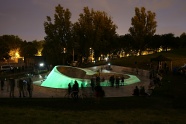
Raphael Hefti, An Alumothermic Reaction Producing Liquid Steel, Filmed at 2000 Frames per Second, 2016
Raphael Hefti, An Alumothermic Reaction Producing Liquid Steel, Filmed at 2000 Frames per Second, 2016
Liverpool Biennial and AccorHotels have commissioned a new site-specific artwork by Swiss artist Raphael Hefti for Pullman Liverpool.
In the art practice of Raphael Hefti, industrial manufacturing processes are pushed to their extremes in order to test the potential of everyday materials. Hefti modifies construction methods, deliberately misapplying processes and even engaging industry technicians and production teams to alter routine procedures, encouraging guided accidents in industrial alchemy. The resulting works – sculptures, photographs, films – document the possibilities of epic material transformations.
For this unique work at the newly constructed Pullman Hotel in Kings Dock, Liverpool, Hefti has created a live performance, film and objects. The project continues his experiments in thermite welding, a process devised in 1893 that is still commonly used in the assembly of high-speed railway tracks. The artist transported nearly 100 tonnes of sand to transform the former construction site of the hotel into an outdoor studio that also acted as a film studio and performance set.
Using the alumothermic reaction required to create molten metal, over the course of two weeks Hefti welded together a body of irregular, tactile steel forms, which are now on display in the lobby of the Pullman hotel. They are a timely consideration of a resource – steel – whose decline in commodity value has had significant repercussions on labour demands worldwide and particularly in Great Britain.
The artist engaged a specialist film crew to capture the performance, which is screened in the rooms of the Pullman hotel as a new artwork. The heat generated in an industrial setting – where temperatures reach 2,500 degrees celcius – means that documenting this type of process is usually impossible. However, the outdoor setting of Hefti’s welding studio allows the film crew to get their cameras remarkably close to the action. Using a 150lb, 4k resolution, ultra-high definition camera that captures 2,000 images per second, the artist collaborated with the film crew to test the possibilities and technical properties of the equipment, exceeding the parameters it has been designed for. Some parts of the equipment even melted in the process.
The result is an incredibly rich video that draws viewers into the mesmerising beauty of heat and combustion. By using the most elaborate filmic equipment available to document a century-old manufacturing process, Hefti’s project oscillates between the industrial and the digital. Witnessing the chemical reactions is a spectacular event live: but the experience of the video reveals an intimate, near-hallucinatory encounter with the type of industrial process that usually remains hidden – speaking to the elusive relationship between ever changing materials and technologies.
An Aluminothermic Reaction Producing Liquid Steel, Filmed at 2000 Frames per Second, 2016
2K high-res film, colour, 15 min, cinema version transferred to HD film for a hotel TV channel at Pullman Hotel, Liverpool
The film can be viewed at the Pullman Hotel. Please ask at the reception and they will guide you to a room where it is being shown.
Every Thursday during Liverpool Biennial 2016, the cinema version of the film will be screened at FACT at 6.30pm.
Raphael Hefti was born in 1978 in Biel, Switzerland. He lives in London and Zurich. Raphael Hefti works with a wide range of materials and processes, from burning Lycopodium moss spores in the making of photograms, to the manufacture of museum glass and the extreme heating of steel and other metals. His actions are often performative, both in private and in public, and he frequently collaborates with industry in his quest to push the limits of what technological and physical actions are designed to do; the results are often charged with an air of mystery in a unique confluence of performance, chemistry and technology. His works have been exhibited widely, including Migros Museum, Zurich (2016) Fondation Vincent Van Gogh, Arles (2015) Centre d’Art Contemporain de Genève (2015) Nottingham Contemporary (2014) CAPC Musée d’Art Contemporain Bordeaux (2013) Camden Art Centre, London (2012) SALTS, Basel (2012) and Kunsthalle Basel (2011). In 2012 he won the Swiss Art Award prize.
Liverpool Biennial
55 New Bird Street
Liverpool L1 0BW
- T +44 (0)151 709 7444
- info@biennial.com
Liverpool Biennial is funded by
Founding Supporter
James Moores




